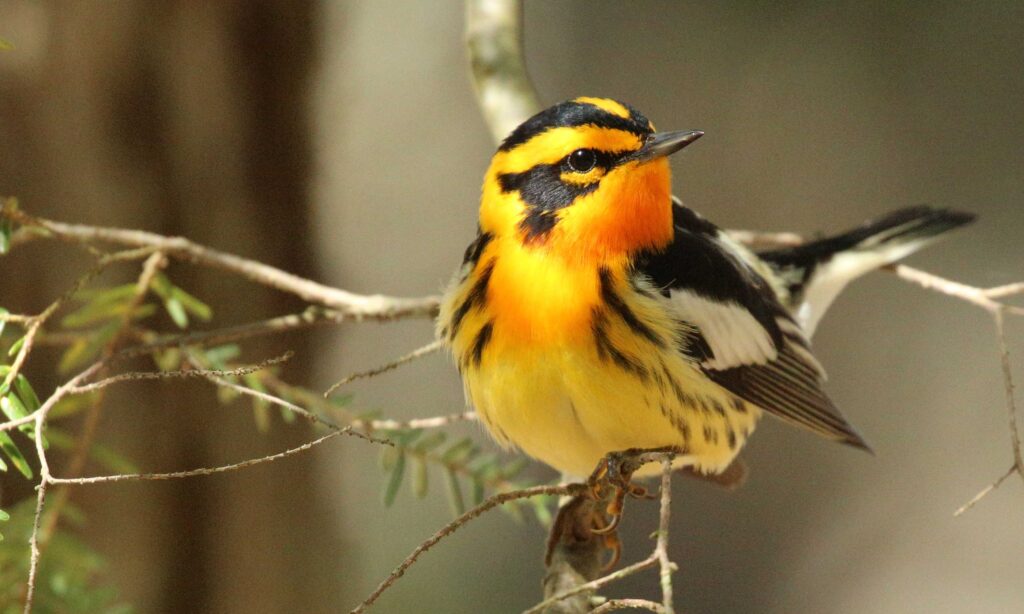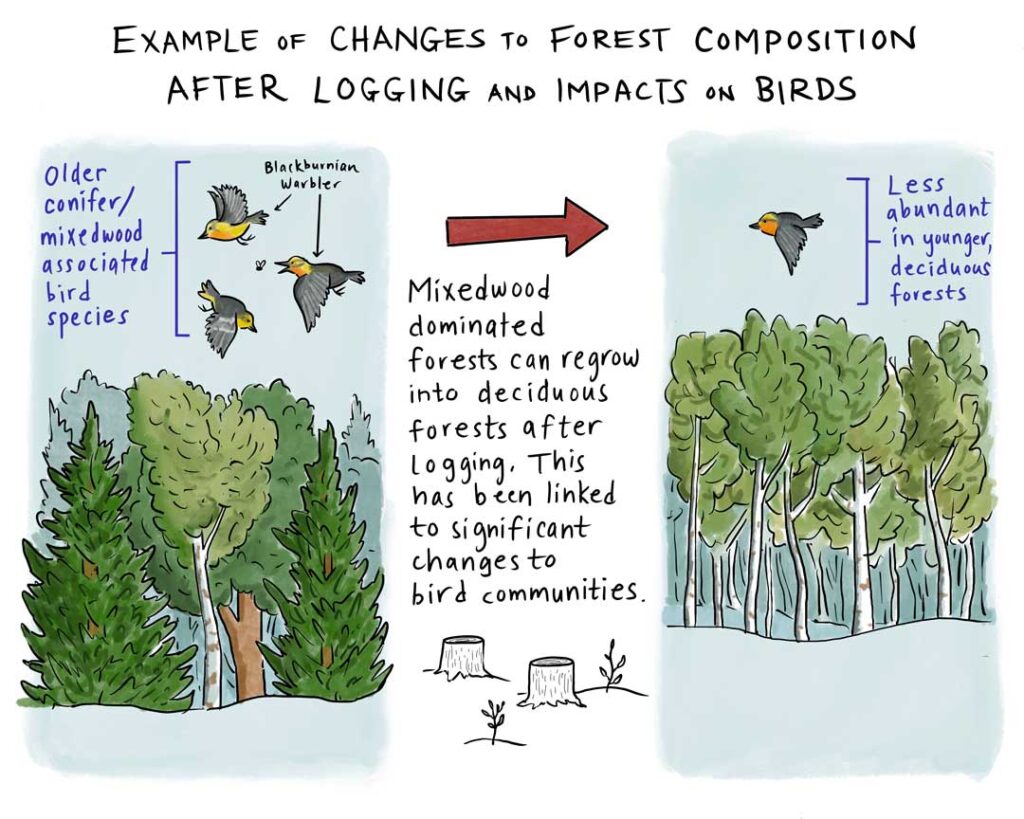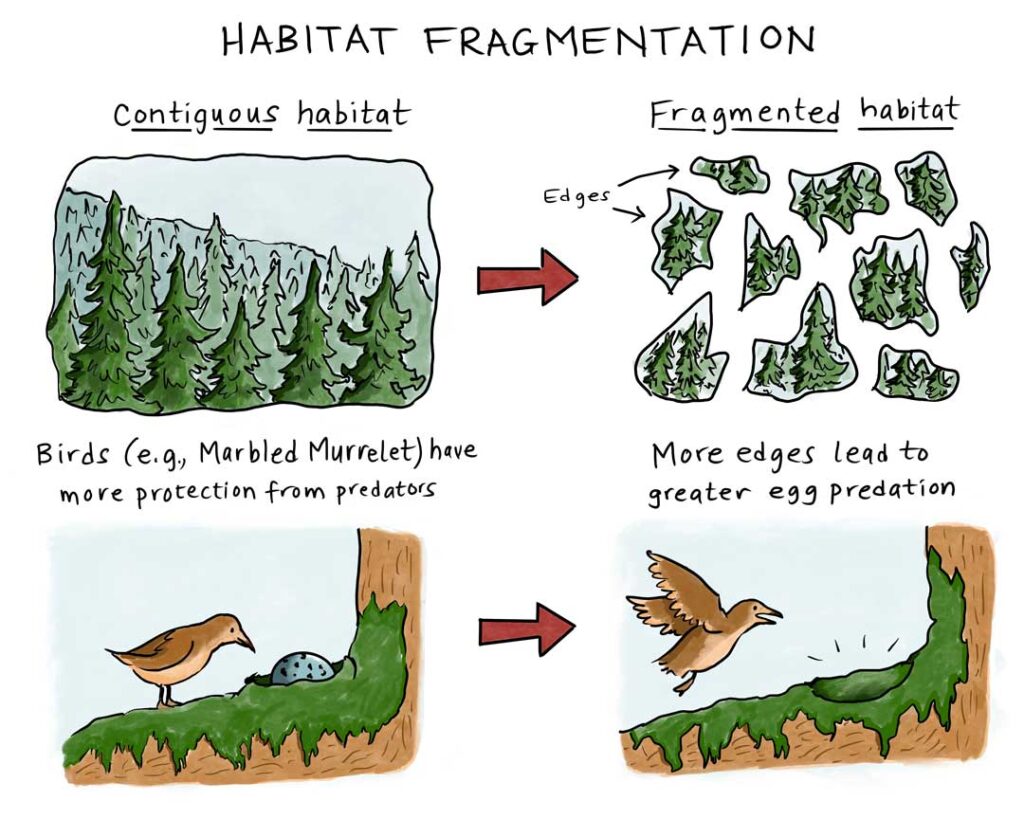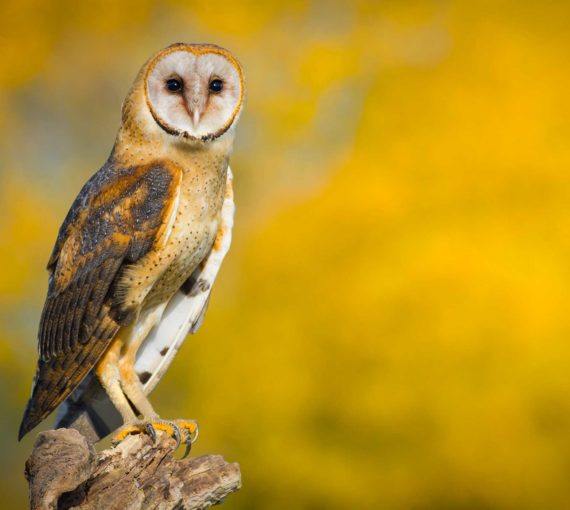Canada, as a signatory to the Glasgow Leaders’ Declaration on Forests and Land Use, must halt and reverse deforestation and land degradation by 2030.

Blackburnian Warbler (Oregon State University via Flickr)
Research published in Science shows bird populations have been severely declining throughout North America. It states, “Species extinctions have defined the global biodiversity crisis, but extinction begins with loss in abundance of individuals that can result in compositional and functional changes of ecosystems” and, “this loss of bird abundance signals an urgent need to address threats to avert future avifaunal collapse and associated loss of ecosystem integrity, function, and services.” The causes of these large-scale bird declines are multifaceted and include habitat loss, reduced insect food due to pesticides and a rising death toll from cats and building collisions. However, there is sufficient science across multiple forest ecosystems in Canada to show that forest degradation has contributed to bird population declines.
One of North America’s tiniest birds, the golden-crowned kinglet is strongly associated with old-growth conifer forest and is adversely affected by some logging operations.
Most people are familiar with the plight of tropical rainforests, having seen shocking images of once-lush and diverse forests converted to cattle pasture or monoculture soy crops.
In Canada, although some forests have been converted to agricultural lands and other uses, in most forests that are logged for wood products, trees generally regrow. Governments in Canada have relied heavily on this tree regrowth to dismiss criticism of forestry practices. The idea that logging replicates or replaces fire is also used to downplay impacts, despite ecological differences between the two.
Even where trees grow back, however, scientists say forest harvesting and regeneration practices can “simplify forest structure, reduce tree species diversity and truncate old-forest age classes”; this is known as forest degradation. It diminishes the ecological value and services of forests. Thus, while Canada may not be implicated in significant “deforestation”, degradation has exacerbated climate change and contributed to biodiversity loss.
Despite the fact that Canada has made a commitment to halt and reverse forest degradation by 2030, it does not currently acknowledge where and to what extent forest degradation is occurring domestically. Canada instead raises facile arguments about the comparatively small percentage of the entire managed forest that is logged each year and ignores the cumulative footprint and associated impacts of decades of industrial logging and other development activities that have degraded and fragmented forests in Canada.
What can birds show us about forest degradation?
Birds are one of the most monitored classes of animals. From scientific studies to backyard bird counts, the data on birds is a valuable source of information on the state of ecosystems more broadly. Birds as a class are also particularly reflective of ecosystem health; they can help highlight where forest degradation is occurring as one bird species, or another, occupies almost every niche in dynamic forest ecosystems throughout Canada.
Here are some examples of forest degradation and its impacts on birds in Canada:
EASTERN CANADA: Bird decline has been explicitly linked to forest degradation in Acadian forests in Eastern Canada. Recent research shows that forest degradation led to habitat declines for the majority of forest bird species, with negative consequences for bird populations, particularly species associated with older forests. While trees in this region regrew after logging (and there was no decline in the area covered by forests), logging changed the forest composition. The researchers estimated that the current average age of trees is approximately 55 years, in contrast to the pre-settlement forest, which had trees averaging 200 years of age. As a result of this forest degradation, the researchers estimated that the Maritime provinces have lost between 30 million and 100 million birds since 1985. Species experiencing the greatest decreases in habitat included the golden-crowned kinglet and Blackburnian warbler, which showed habitat declines greater than 25 per cent. Nine bird species in the study area declined at rates exceeding 30 per cent over the past 10 years, meeting criteria to be listed as threatened under Canadian endangered species legislation.
“Old forest declined by 39% over the period we observed. Over the same period, forest cover actually increased by a net 6.5%. That pattern of extensive harvest of old forest, followed by rapid regeneration of young forest and then subsequent harvest before maturity is attained, seems to be common in many forest regions of North America and northern Europe.” – Dr. Matthew Betts, 2022
NORTHWEST QUEBEC: Research in northwestern Quebec on mixed-wood boreal forests (which include a mix of conifer and deciduous trees) found that landscape-scale shifts from mixed-wood to deciduous in human-disturbed landscapes were the main cause of changes in mature-forest bird communities.
Changes in the ages of dominant trees in a forest is only one factor that may affect bird habitat. Logging can modify the structure and composition of forests, including leaving less coarse woody debris (rotting logs and standing dead trees) than would be left after natural disturbance. For example, research suggest that in conifer forests in Quebec, resident birds that don’t migrate are particularly sensitive to change, as most of them are cavity nesters that rely on the forest structure found in older forests.

Research has shown logging of mixedwood forests can lead to shifts to forests that are dominated by deciduous trees. Credit: Courtenay Lewis
ONTARIO: Research in the managed forest in Ontario showed that total bird abundance and species richness were lower after logging than after fire in regenerating stands approximately 21 to 80 years since disturbance (described as “mid-regenerating”). Although no bird species was completely missing from any stand type, eight per cent of species in young and 34 per cent in mid-regenerating stands were detected significantly less often after logging than after fire. These results suggest that widespread replacement of fire with logging as the dominant disturbance type can shift the relative abundance of species within Ontario’s forest-dwelling bird community.
BRITISH COLUMBIA: A study found that increased fragmentation associated with logging of old-growth forests in British Columbia increased egg predation on marbled murrelets—a threatened seabird that relies on coastal old-growth forests in B.C. for nesting. They concluded that predation risk at nests of marbled murrelets is likely to be higher near clearcuts and roads than in interior forests, and higher in fragmented landscapes than in relatively undisturbed old-growth forests, showing that forest fragmentation as a result of industrial logging can degrade forest function. As few as 357,900 marbled murrelets are left, including an estimated 99,100 in B.C., where the species has lost an estimated 22 per cent of its habitat over three generations, according to the Committee on the Status of Endangered Wildlife in Canada (COSEWIC). Recently, a Federal Court judge concluded that Canada’s minister of environment and climate change should have considered that habitat loss and degradation is a key driver in the decline of most at-risk bird populations. Logging in B.C.’s old-growth forests has also driven the extirpation of the spotted owl.

Where cutblocks and logging roads have fragmented forests, research has shown that egg predation has increased, and bird species, such as marbled murrelet, have declined. Credit:Courtenay Lewis
While these studies spotlight particular forest regions, broader research shows similar trends. Coupled with climate change and natural disturbances, the rapid expansion of industrial development in the boreal forest, including forestry, energy and mineral resource extraction, is expected to further transform boreal bird habitats.
“Industrial-scale logging has caused profound changes in forest landscapes across many parts of the world including in Canada and those changes have major impacts on bird populations. It’s time for an open and honest discussion about these issues to improve industrial forestry management practices for a healthier and more sustainable future.” – Dr. Jeff Wells, National Audubon Society
An important ecological function of forests is to provide habitat. But birds are not simply passive users of their habitat—they also shape the ecosystems of which they are a part. Their decline in such drastic numbers in forests begins a feedback loop, further contributing to changes in forest dynamics.
These and other studies illustrate that habitat loss—which includes forest degradation—is a major threat to birds in Canada. How can the Government of Canada help to avert this threat? By first acknowledging where, why and how forest degradation is occurring in Canada, and working with provincial and Indigenous governments to halt forest degradation and restore forests where degradation has occurred.
Help Canada’s degraded forests!
This blog focuses on how industrial logging can lead to forest degradation and its impacts on birds. It is part of a joint blog series by the David Suzuki Foundation (DSF) and NRDC exploring forest degradation in Canada.
Our work
Always grounded in sound evidence, the David Suzuki Foundation empowers people to take action in their communities on the environmental challenges we collectively face.




